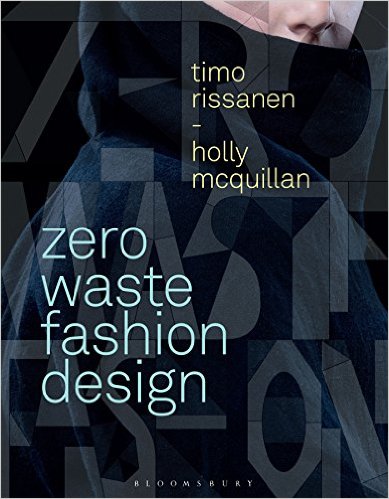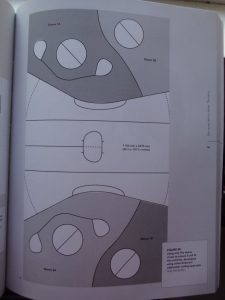Book review Zero Waste Fashion

The book Zero Waste Fashion by Timo Rissanen and Holly McQuillan (Bloomsbury 2016) has arrived and I’m keen to share my thoughts on it with you. I ordered it last month when I wrote Considering zero waste fashion, which has become my second highest visited post.
I cannot deny a frisson of excitement went through me as I opened this book!
There are many things I liked about this book, and I think I could learn a lot from it. I appreciated the generous and practical ideas for getting started with zero waste patternmaking.
The book outlines techniques and considerations for patternmaking, ideas for grading zero waste patterns, adapting to different fabric widths, and using CAD and digital printing if you have it.
The text is brought to life with photos and patterns on almost every page. There are links to online patterns which are free to download.
The book is enlivened with interviews and profiles of fashion designers, studio owners, authors and teachers. Not all of them champion zero waste, but certainly all of them have experimented with new and creative ways of pattern cutting. I did get a mild feeling of experimenting for the sake of experimenting in an academic, theoretical way. These are just clothes, you know. However, being encouraged to experiment and try stuff is the whole point with this book. Some is very inspiring; some designers have created whole collections that are zero waste.
Of interest to me was an interview with Winifred Aldrich. Her book was our patternmaking text book when I was a fashion student. I had no idea she was such a highly regarded researcher (in fact I didn’t know anything about her).
Zero Waste Fashion is let down by some of the photographic images. Alas, many of the clothes are black and therefore difficult to photograph.

Some of the diagrams are in need of a bit more explanation, for example this one on page 105. I would kind of like to try this but I have no idea how to sew it together. More hand-holding, please!
If you love making patterns, Madeleine Vionnet’s pattern cutting, Pattern Magic books, and thinking creatively within parameters, then this book is bedtime reading for you.
Cheers!
Disclosure: I ordered Zero Waste Fashion from our library for this review. I’m happy to say I liked it so much I decided to order my own copy.
Update Oct 2019: take a look at Zero Waste Sewing, due to be published March 14th 2020.
Sal: here’s Julian Robert’s subtraction cutting PDF:


Thanks Liz for sharing what your thoughts about your new book. Once I have understood the concept, to create designs through Zero Waste approach might not be so difficult but for now, it is still a mystery for me because I have not experimented anything. As you suggested it could be a good bedtime reading material so I might borrow the book from the library like you did. I hope there are a lot of photos to show their examples in the book. Thanks again!
Hi Chiggy,
I think you would enjoy the challenge of No Waste in your designing, and I don’t think you would find it difficult. All the usual patternmaking stuff still applies (fit, sizing, pattern accuracy, geometry, making toiles, etc) but the design, pattern and fabric layout are more closely linked. It has the potential to yield some unusual and interesting clothes. You would find this book easier to read than Shaping Sustainable Fashion because it’s a lot more “hands on”.
Thanks for your comment!
Cheers, Liz
I realised this week that patchwork quilts are a way to make regular patterns into zero waste.
Sure are! Patchwork quilts have their roots in thrift.
Quilting always reminds me of this – http://www.theonion.com/article/grueling-household-tasks-of-19th-century-enjoyed-b-1519
But when I was searching for that article, I found this one which is even better – http://www.theonion.com/blogpost/the-first-rule-of-the-quilting-society-is-you-dont-10795
Ha! They are pretty funny. I did not intend for the comments on this post to become an exchange of quilting funnies, but have you read this one? It’s hilarious. http://kaythesewinglawyer.blogspot.com.au/2015/06/a-speech-on-quilting.html
See what you mean about hand-holding — huh.
Does the text say what the garment is meant to be? The sleeve parts B look like half sleeves — do you think that they’re rotated by 180 and joined to the same colour parts A. I don’t mind matching a curved and a straight edge, but can’t see how this would work. Are we to assume that the holes are cut out ready for global-warming ventilation? Or are they large notches?
Bet all my remaining FQs (ex-quilter) that if it is photographed, then it, too, is in black!
Looking at it now, I can see it’s a top. The white part in the middle is the body and the oval-ish shape in the centre is the head hole. The shaded shapes either side are sleeves but I don’t know exactly how they work. I think the arms pass through the all the holes? It’s based on Julian Roberts’s subtraction cutting approach – I’ve put some extra-curricular reading at the bottom of the post for you 🙂
Thanks for the JR pdf. There’s a pattern in there which shows a sliver of light on the one here — see the lost luggage trousers on page 106/108. The curved line joining the two teardrops is a hem and the circles are notches of a kind. It looks like they’re twisted and paired to make the odd pleats.
I find this frustrating as usually I can look at a pattern and see how it’s assembled and vice versa.
Ha ha — I met someone the other day wearing a homemade dress and duster jacket. I had to excuse myself immediately for staring at her as I simply had to see how she’d altered the bust darts!
I have an unusual construction to share in return — it’s by Miyake and is from Jackets, Coats and Suits from Threads. (http://allonestring.co.uk/wpimages/2021/threads.jpg – a large image featuring gardener’s fingernails, which I’ll delete soon) I had to trace and cut it out to make sense of it! While not ZW, it’s certainly fun
Thanks for this Sal; I think I’ll try it out too.
Just discovered JR has a Youtube channel with some demonstrations of his cutting.